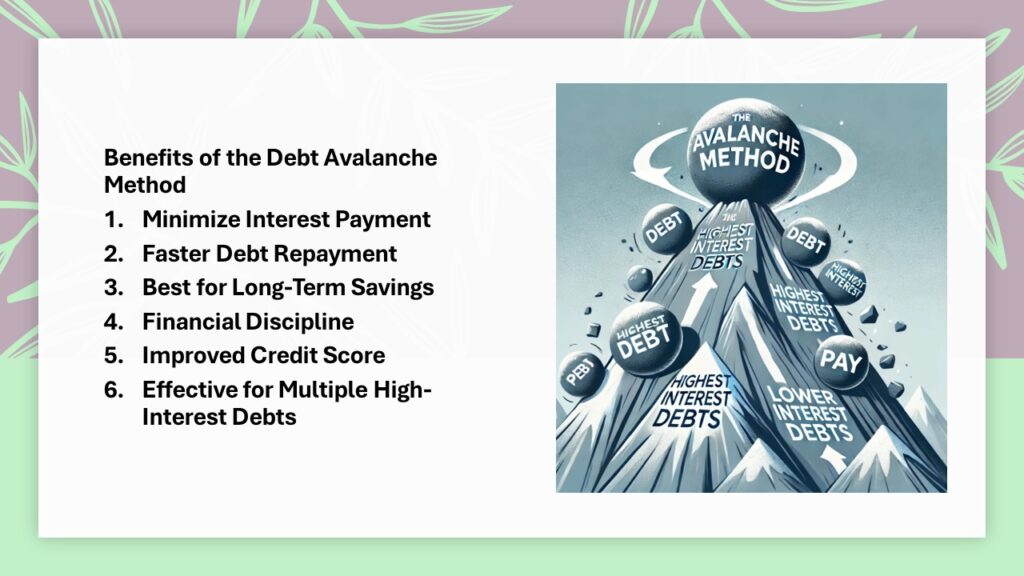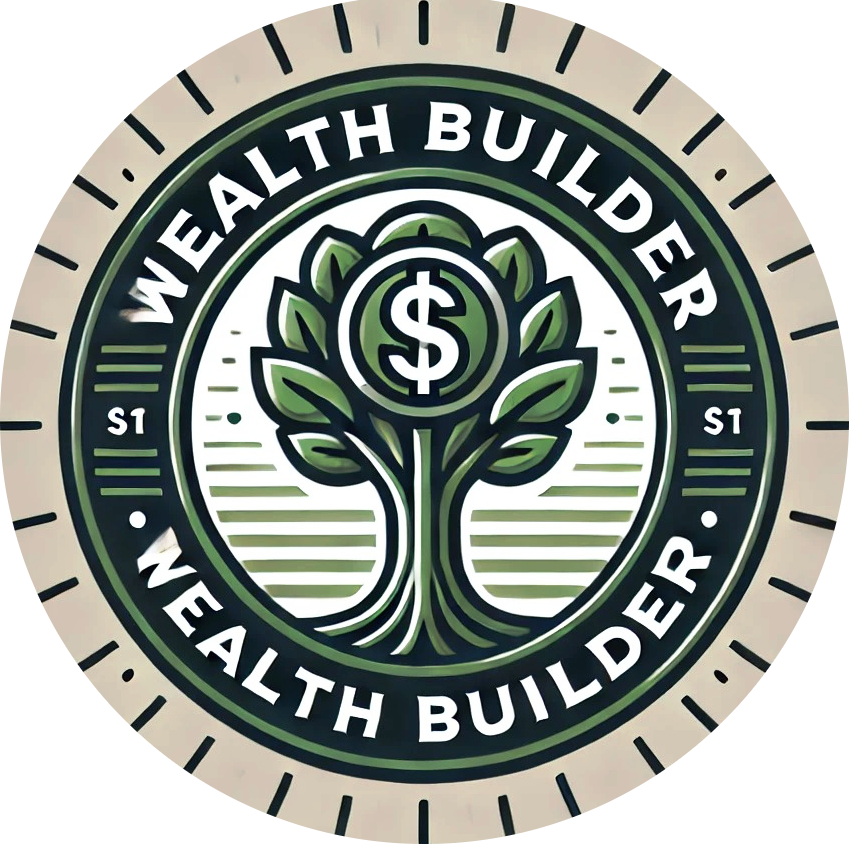Introduction
Paying off debt can seem like a huge task, especially when you have more than one debt to handle. But don’t worry! The Debt Avalanche Method is a smart way to tackle your debts and save money on interest. Let’s walk through how you can use this method to get out of debt faster.

How The Debt Avalanche Method Works
1. List Your Debts by Interest Rate
First things first, you need to know what you’re dealing with. Make a list of all your debts, like credit cards, student loans, or any other money you owe. But instead of listing them by how much you owe, write them down based on their interest rates. Start with the debt that has the highest interest rate and go down to the one with the lowest. This step is super important because the Avalanche Method is all about focusing on those high-interest debts first.
2. Keep Up with Minimum Payments
Next, make sure you’re keeping up with the minimum payments on all your debts. This is important because it keeps you in good standing with the people or companies you owe money to. But here’s the trick: any extra money you have, like from a part-time job, birthday cash, or savings, should go toward paying off the debt with the highest interest rate. This way, you start chipping away at the most expensive debt first.
3. Target the Highest-Interest Debt
Now that you’ve figured out which debt has the highest interest rate, it’s time to go after it. Use any extra money to make bigger payments on this debt. By doing this, you’ll pay it off faster and save money because less of your payment will go toward interest. Once you’ve paid off that first debt, it’s time to move on to the next one on your list.
4. Move on to the Next Debt
After paying off the highest-interest debt, it’s time to move on to the next one on your list. Take the money you were using to pay off the first debt and add it to the minimum payment of the next debt. Keep doing this until all your debts are paid off. It might take some time, but with each debt you pay off, you’ll feel more in control and motivated.
5. Stay Focused and Track Your Progress
The Avalanche Method might not give you quick wins like other methods, but it will save you the most money in the long run. Stay focused and keep track of how much progress you’re making. You can even create a chart or a graph to see how far you’ve come. Watching your debt shrink over time is a great way to stay motivated!
6. Watch Out for Variable Interest Rates
Finally, if any of your debts have interest rates that can change (these are called variable interest rates), keep an eye on them. Sometimes, these rates can go up, which means your debt could get more expensive. If this happens, you might need to adjust your plan and focus on this debt sooner. Being flexible and aware of these changes will help you stick to your plan and pay off your debt as efficiently as possible.
Pros and Cons of the Debt Avalanche Method
The Debt Avalanche Method is a great way to tackle debt, but like everything, it has its good and not-so-good sides. Let’s break down the pros and cons of using this method in a way that’s easy to understand.
Pros
- Saves You Money on Interest
- One of the best things about the Avalanche Method is that it helps you save money. By paying off the debts with the highest interest rates first, you end up paying less interest overall. This means more of your money goes toward actually getting rid of your debt, not just paying the extra fees.
- Gets You Out of Debt Faster
- Because you’re tackling the most expensive debts first, you can pay off everything faster. The less money you’re spending on interest, the quicker you can see those debt numbers go down.
- It’s the Smartest Way Financially
- The Avalanche Method is the best choice if you want to be smart with your money. By focusing on high-interest debts, you’re making sure your money is working as hard as possible to help you become debt-free.
Cons
- It Takes Time to See Progress
- One downside is that it might take a little while before you start seeing big changes. If your highest-interest debt is also your biggest debt, it could be a while before you pay it off. This can be tough because everyone likes to see quick results!
- You Need to Stick with It
- The Avalanche Method requires patience and commitment. Since it might be a while before you see any big wins, it’s easy to get discouraged. You need to stay focused and remember that this method will pay off in the long run.
- It Can Be a Bit Complicated
- If some of your debts have interest rates that can change, things can get a bit tricky. You might have to adjust your plan if one of those rates goes up. This can make the Avalanche Method a little harder to follow than other methods.
Hypothetical Scenario: Alex and the Debt Avalanche Method
Let’s imagine Alex, who has a total debt of $100,000 from different sources. Alex wants to use the Debt Avalanche Method to pay off his debt as quickly and efficiently as possible. Here’s how Alex can tackle it:
Alex’s Debts:
- Credit Card Debt 1: $25,000 with a 20% interest rate
- Personal Loan: $30,000 with a 10% interest rate
- Student Loan: $35,000 with a 5% interest rate
- Credit Card Debt 2: $10,000 with a 15% interest rate
Step 1: List the Debts by Interest Rate
Alex starts by listing all his debts from the highest interest rate to the lowest:
- Credit Card Debt 1: 20% interest ($25,000)
- Credit Card Debt 2: 15% interest ($10,000)
- Personal Loan: 10% interest ($30,000)
- Student Loan: 5% interest ($35,000)
Step 2: Keep Up with Minimum Payments
Alex makes sure to pay the minimum required payments on all of his debts. This helps him avoid late fees and keeps his credit in good standing. However, Alex’s main focus is on paying off Credit Card Debt 1 first, because it has the highest interest rate.
Step 3: Focus on the Highest-Interest Debt
Alex has some extra money each month after covering his basic living expenses and the minimum payments on all his debts. He decides to put all of that extra money toward Credit Card Debt 1, which has the 20% interest rate.
For example, let’s say Alex can afford to put an extra $1,000 per month toward his debt. He directs this $1,000 to Credit Card Debt 1 on top of its minimum payment. By doing this, Alex reduces the balance on this high-interest debt faster, meaning he’ll pay less interest over time.
Step 4: Move On to the Next Debt
After several months of making these extra payments, Alex finally pays off Credit Card Debt 1. Now, he takes the $1,000 extra (plus the amount he was paying on Credit Card Debt 1) and adds it to the payment for Credit Card Debt 2, which has the next highest interest rate at 15%.
By focusing on the next highest interest debt, Alex continues to chip away at his total debt. Once Credit Card Debt 2 is paid off, he’ll move on to the Personal Loan, and finally, the Student Loan.
Step 5: Stay Committed
Throughout this process, Alex stays focused and keeps track of his progress. He knows that by sticking to the Avalanche Method, he’s saving money on interest and paying off his debt in the most efficient way possible.
Final Outcome
Using the Debt Avalanche Method, Alex can pay off his $100,000 debt in a way that minimizes the total interest he pays. Even though it might take some time to see the first debt disappear, Alex knows that this method will save him the most money in the long run and help him become debt-free faster.
Conclusion
Using the Debt Avalanche Method is a smart way to pay off debt, especially if you want to save money on interest. By focusing on the debts with the highest interest rates first, you’ll be able to get out of debt faster and keep more money in your pocket. It might take a little patience, but in the end, this method can help you achieve financial freedom. So, start making your list and watch your debt disappear!

